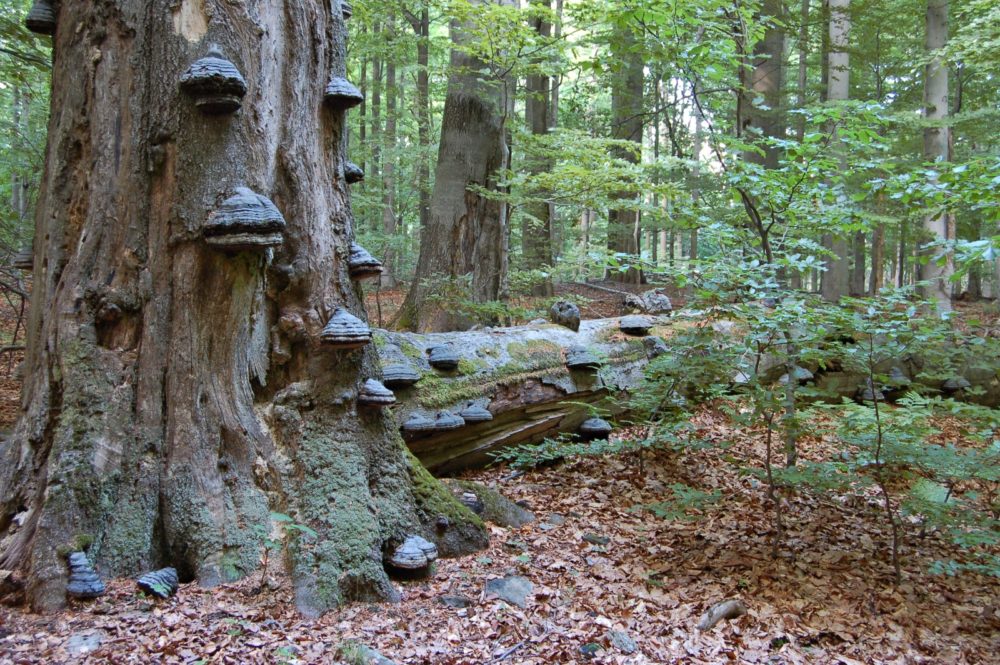Rarity: Tinder fungus (tinder polypore), a wood-destroying fungus parasitizing European beech, was found for the first time on Norway spruce in the Beskydy Mountains
 Tinder fungus (Fomes fomentarius) is a widespread wood-destroying fungus typical of beech and mixed stands with admixture of beech. It causes intense white wood rot, which ultimately significantly reduces the biomechanical vitality and static stability of beech trees in forest ecosystems and also in non-forest environments, as well. Until 2023, there were no published data on the colonization of spruce by the tinder fungus in the Carpathians.
Tinder fungus (Fomes fomentarius) is a widespread wood-destroying fungus typical of beech and mixed stands with admixture of beech. It causes intense white wood rot, which ultimately significantly reduces the biomechanical vitality and static stability of beech trees in forest ecosystems and also in non-forest environments, as well. Until 2023, there were no published data on the colonization of spruce by the tinder fungus in the Carpathians.
Photo: Sporocarps of tinder fungus on spruce stump at forest edge near the Horní Lomná village. Author Kristýna Murgašová
During a mycological survey in the Moravian-Silesian Region of Silesia, near the Horní Lomná village, scientists discovered sporocarps of tinder fungus on a spruce stump on November 10, 2018.
Research team has published this information in the paper Prvý záznam o výskyte trúdnika Fomes fomentarius na smreku v Karpatoch s poznámkami o jeho výskyte na ihličnatých drevinách v Európe (The first record of the occurrence of the tinder polypore, Fomes fomentarius on spruce in the Carpathians with notes on its occurrence on conifers in Europe), issued in the scientific journal Reports of Forestry Research 3/2023.
The discovery of this wood-destroying fungus and the following record represents the first data on its occurrence on spruce in the Carpathians:
The Czech Republic, Moravian-Silesian Region, District Frýdek-Místek, ca 200 m south-east from the „Pod Kyčmolem Wellness Hotel“, near the Horní Lomná village, 605 m a.s.l,, at the edge of recreationally used spruce forest, on a stump of Picea abies, November 10, 2018, leg. & det. K. Murgašová, rev. J. Kaper.
 Photo: Sporocarp of tinder fungus on European beech. Author Jan Řezáč
Photo: Sporocarp of tinder fungus on European beech. Author Jan Řezáč
Until now, there has only been one known record of the colonization of spruce by this fungus in Europe, which was from the Central Bohemian Highlands (Libochovka, Hluboká, Vlasák, 2009). Additionally, there have been three records from the Austrian Alps (Tyrol, Innsbruck, southern side of the Alps, Dresch et al., 2015).
The discovery of the wood-destroying fungus sporocarps on Norway spruce in the Central Bohemian Highlands (Vlasák, 2009) is the first time the ungulate fungus has been found on spruce in Europe. However, this species had already been experimentally shown to colonize spruce wood earlier.
Other records of colonization of other conifer species (for example silver fir) in Europe are very rare, similar to records of spruce colonization by ungulates. Positive colonization of the root system of Scots pine seedlings was also experimentally demonstrated.
More detailed information can be found in paper The first record of the occurrence of the tinder polypore, Fomes fomentarius on spruce in the Carpathians with notes on its occurrence on conifers in Europe (Prvý záznam o výskyte trúdnika Fomes fomentarius na smreku v Karpatoch s poznámkami o jeho výskyte na ihličnatých drevinách v Európe), see here.
Authors of paper: Ján Gáper, Technická univerzita ve Zvolenu (Technical University in Zvolen); Kristýna Murgašová, Ostravská univerzita (University of Ostrava); Peter Pristaš, Univerzita Pavla Jozefa Šafárika, Košice (Pavol Jozef Šafárik University in Košice); Svetlana Gáperová, Univerzita Mateja Bela, Banská Bystrica (Matej Bel University, Banská Bystrica); e-mail: jan.gaper@tuzvo.sk
Prepared by: Jan Řezáč, FGMRI (VÚLHM, v. v. i.), e-mail: rezac@vulhm.cz
